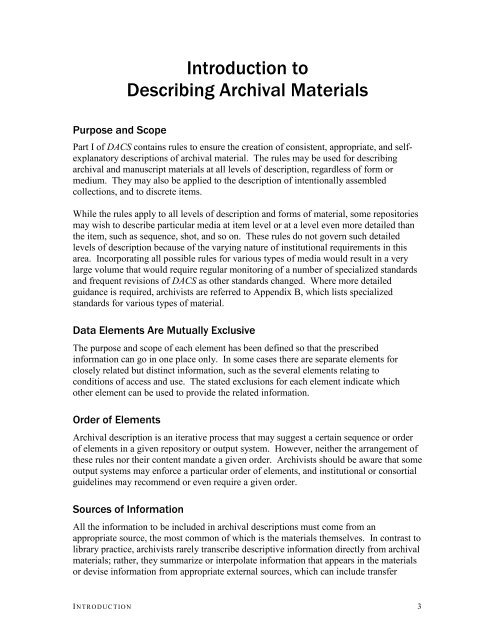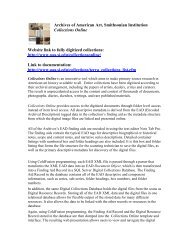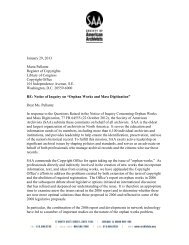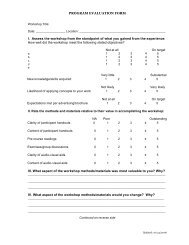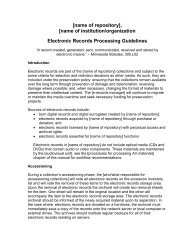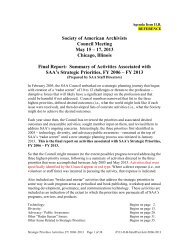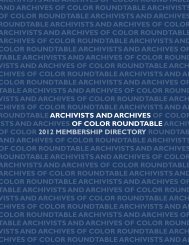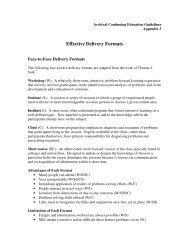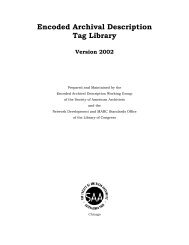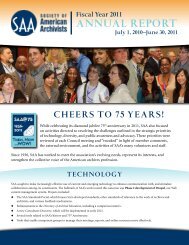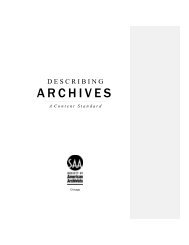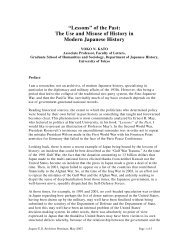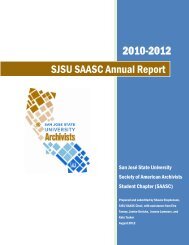- Page 1 and 2: Agenda Item II.A.Society of America
- Page 3 and 4: APPENDIX A: Full text of revisionD
- Page 5 and 6: ContentsPrefaceAcknowledgementsStat
- Page 7 and 8: PrefaceDescribing Archives: A Conte
- Page 9 and 10: Finally, the subcommittee considers
- Page 11 and 12: DACS 2013 DACS 2004Minimum, Optimum
- Page 14 and 15: Statement of PrinciplesThe followin
- Page 16 and 17: serves to identify archival materia
- Page 18 and 19: which the descriptive system is ent
- Page 20 and 21: Overview of Archival DescriptionThe
- Page 22 and 23: Access points fall into six broad c
- Page 24 and 25: created. Examples of such concepts
- Page 27: PART IDescribing Archival Materials
- Page 31 and 32: • Square brackets, as prescribed
- Page 33 and 34: encoded, multilevel finding aids—
- Page 35 and 36: Single-level OptimumA single-level
- Page 37 and 38: Multilevel OptimumThe top level of
- Page 39 and 40: CHAPTER 2Identity Elements2.1 Refer
- Page 41 and 42: Country Identifier2.1.5. Provide a
- Page 43 and 44: 2.3 Title Element (Required)Purpose
- Page 45 and 46: elsewhere in the descriptive record
- Page 47 and 48: the corporate body may be recorded
- Page 49 and 50: Topic of the archival unit2.3.22. O
- Page 51 and 52: to provide details about the availa
- Page 53 and 54: 2.4.12. At all levels of descriptio
- Page 55 and 56: 2.5 Extent Element (Required)Purpos
- Page 57 and 58: Multiple Statements of Extent2.5.7.
- Page 59 and 60: 2.6 Name of Creator(s) Element (Req
- Page 61 and 62: applied from a controlled vocabular
- Page 63 and 64: 2.7 Administrative/Biographical His
- Page 65 and 66: New York representative for the Chi
- Page 67 and 68: The Gordon family of Savannah, Ga.,
- Page 69 and 70: attend the Law School at the Univer
- Page 71 and 72: The Goldband Recording Corporation
- Page 73 and 74: Administrative history for the Phys
- Page 75 and 76: element is a good source for the ac
- Page 77 and 78: scattered throughout the collection
- Page 79 and 80:
3.2 System of Arrangement Element (
- Page 81 and 82:
CHAPTER 4Conditions of Access and U
- Page 83 and 84:
4.2 Physical Access Element (Added
- Page 85 and 86:
4.3 Technical Access Element (Added
- Page 87 and 88:
4.4 Conditions Governing Reproducti
- Page 89 and 90:
4.4.12. Give information about any
- Page 91 and 92:
CO ND IT IO N S OF ACCESS AND USE E
- Page 93 and 94:
An index to the content of the writ
- Page 95 and 96:
to prevent capture and were retriev
- Page 97 and 98:
Identifying Numbers5.2.5. Optionall
- Page 99 and 100:
Appraisal criteria for file retenti
- Page 101 and 102:
CHAPTER 6Related Materials Elements
- Page 103 and 104:
6.2 Existence and Location of Copie
- Page 105 and 106:
6.3 Related Archival Materials Elem
- Page 107 and 108:
6.4 Publication Note Element (Added
- Page 109 and 110:
Album pages were detached from thei
- Page 111 and 112:
The original arrangement and folder
- Page 113 and 114:
CHAPTER 8Description Control Elemen
- Page 115:
PART IIArchival Authority Records
- Page 118 and 119:
ecords that are linked to the archi
- Page 120 and 121:
Structure and NumberingPart II cons
- Page 122 and 123:
usually contain detailed informatio
- Page 124 and 125:
CHAPTER 10Form of the Name10.1 Auth
- Page 126 and 127:
Society of American Archivists. Nat
- Page 128 and 129:
11.1.3. For persons, if both the da
- Page 130 and 131:
11.3.2.. For persons, as appropriat
- Page 132 and 133:
Sea. The greater control of two are
- Page 134 and 135:
CHAPTER 12Related Persons, Families
- Page 136 and 137:
Thomas Cadell was friend and publis
- Page 138 and 139:
CHAPTER 13Authority Record Manageme
- Page 140 and 141:
13.5. Level of detail13.5.1. Indica
- Page 142 and 143:
CHAPTER 14Related Archival Material
- Page 144 and 145:
14.4. Dates of Related Resources an
- Page 146 and 147:
Cadell & Daviesn 81066332Type of Re
- Page 148 and 149:
Appendices
- Page 150 and 151:
Archival Description (RAD), 38 acco
- Page 152 and 153:
The Statement of Principles, a revi
- Page 154 and 155:
APPENDIX BCompanion StandardsAs ind
- Page 156 and 157:
Gregory A. Pass; Association of Col
- Page 158 and 159:
USMARC Code List for Organizations.
- Page 160 and 161:
DACS to ISAAR(CPF) to EAC(CPF)APPEN
- Page 162 and 163:
Families12.3 Nature of relationship
- Page 164 and 165:
4.5 Languages and Scripts of 7.12;
- Page 166 and 167:
3.4.1 Conditions governing access 4
- Page 168 and 169:
7. Notes 41 , 5008. Description co
- Page 170 and 171:
APPENDIX BDescribing Archives: A Co
- Page 172 and 173:
Acronyms should be spelled out at l
- Page 174 and 175:
Documentation of theConsultation Pr
- Page 176 and 177:
Suggested Revisions to DescribingAr
- Page 178 and 179:
Decide whether or not to remove AAC
- Page 180 and 181:
oooHow you would do it in MARCHow y
- Page 182 and 183:
-----------------------------------
- Page 184 and 185:
E-mail: jcarll@radcliffe.eduPhone:O
- Page 186 and 187:
that may be considered offensive we
- Page 188 and 189:
-----------------------------------
- Page 190 and 191:
Appendix 4: Levels of DescriptionDA
- Page 192 and 193:
Records of the President of Harvard
- Page 194 and 195:
* Box 1, Folder 1* Box 1, Volume 1*
- Page 196 and 197:
-----------------------------------
- Page 198 and 199:
My observation is that many finding
- Page 200 and 201:
If the body has changed names and h
- Page 202 and 203:
In my teaching, in reviewing the wo
- Page 204 and 205:
o reprintso formal reportso procedu
- Page 206 and 207:
-----------------------------------
- Page 208 and 209:
2.3 Title--------------------------
- Page 210 and 211:
- Fundraising and development trave
- Page 212 and 213:
have trouble applying the notions o
- Page 214 and 215:
-----------------------------------
- Page 216 and 217:
2.4.16Clarify this rule to discoura
- Page 218 and 219:
Express extent of physical holdings
- Page 220 and 221:
2.6 Name of Creator(s)-------------
- Page 222 and 223:
Appendix 11: Scope and ContentDACS
- Page 224 and 225:
-----------------------------------
- Page 226 and 227:
Arrangement statements need to be p
- Page 228 and 229:
Appendix 14: Describing CreatorsDAC
- Page 230 and 231:
DACS REVISION:Submitted: 5/4/2011Na
- Page 232 and 233:
DACS section/p.number of therevisio
- Page 234 and 235:
Creator(s) Elementsection“devised
- Page 236 and 237:
2.6.3 commentary,third sentenceChan
- Page 238 and 239:
Comment: I’m not sure thisstateme
- Page 240 and 241:
7.1.2)2628 (1968)Note: Dated in acc
- Page 242 and 243:
2.7 p. 41 paragraph in commentary:
- Page 244 and 245:
known to be either one of twoyears,
- Page 246 and 247:
century or centuries in which theco
- Page 248 and 249:
similar to that found inISAD(G), DA
- Page 250 and 251:
9 New discovery systems are likely
- Page 252 and 253:
unknown?)One other small thing, the
- Page 254 and 255:
evision as TS-DACS undertook it,esp
- Page 256 and 257:
chapter, but I think yourterminolog
- Page 258 and 259:
2.2. Chapter 1. Levelsof Descriptio
- Page 260 and 261:
items, number of containers orcarri
- Page 262 and 263:
Rules for HistoricalSummary (9.18-9
- Page 264 and 265:
Syracuse University315-443-2081mrro
- Page 266 and 267:
Similarly, I’d rework the languag
- Page 268 and 269:
University Archives, Department of
- Page 270 and 271:
BLANK BLANK[Roger CD #, eg. CD09050
- Page 272 and 273:
use of access points in archival de
- Page 274 and 275:
9.5. Record the name of the entity
- Page 276 and 277:
1501 or 1507 (date of birth)1826 Ju
- Page 278 and 279:
Juneau, Alaska (place of residence)
- Page 280 and 281:
to the viscounty of Campden and a p
- Page 282 and 283:
Repository Code9.36. Provide a repo
- Page 284 and 285:
(EAC-CPF encoding indicating that t
- Page 286 and 287:
Form according to other rules (11.9
- Page 288 and 289:
Comment: “Uniquely” is too high
- Page 290 and 291:
● Authority record identifier (se
- Page 292 and 293:
Appendix C: CrosswalksP. 221: Add t
- Page 294 and 295:
and punctuationTranscription:DACSre
- Page 296 and 297:
Minimal levelrequirementsDCRM(G)Bas
- Page 298 and 299:
Table 3: Comparison of some specifi
- Page 300 and 301:
Extent:Similarinstruction in Gand D
- Page 302 and 303:
happen in courts. Whether this woul
- Page 304 and 305:
Collections that incorporate legal
- Page 306 and 307:
suit code 441), 2825 / 211 equal em
- Page 308 and 309:
correspondence between the court an
- Page 310 and 311:
the principles of archival arrangem
- Page 312 and 313:
parties claims.[...] Christopher Fe
- Page 314 and 315:
clearinghouse.net.Christopher Felke
- Page 316 and 317:
Robert Burton Weissman Preservation
- Page 318 and 319:
Other ThingsGuidance/examples are p
- Page 320 and 321:
Reviewers were pleased overall with
- Page 322 and 323:
Approximately 275 digital image and
- Page 324 and 325:
great instance of a gratuitous exam
- Page 326 and 327:
You're decision to include a textua
- Page 328 and 329:
D E S C R I B I N G!"#$%&'()_______
- Page 330 and 331:
#*+,-+,.)!!)*+,&%+! -!.%/0(12+3'+4+
- Page 332 and 333:
1-=03-)Archives, Personal Papers, a
- Page 334 and 335:
Level of Description element from I
- Page 336 and 337:
!3E+*F9-@6-
- Page 338 and 339:
(,0,-0,G1-)*=)!1374809)$*9@4+6.Arch
- Page 340 and 341:
serves to identify archival materia
- Page 342 and 343:
which the descriptive system is ent
- Page 344 and 345:
H8-184-F)*=)!1374809)2-.314?,4*+))T
- Page 346 and 347:
Access points fall into six broad c
- Page 348 and 349:
Scope and Content Element (3.1) Adm
- Page 350:
!/!"B)%)!!!2-.31454+6)!1374809):0,-
- Page 353 and 354:
documents and other acquisition rec
- Page 355 and 356:
6 DESCRIBING ARCHIVES: A CONTENT ST
- Page 357 and 358:
systems or products. DACS does not
- Page 359 and 360:
(4+69-N9-8-9)H?,4
- Page 361 and 362:
:G9,49-8-9)H?,4
- Page 363 and 364:
#$!/B'")O)!%@-+,4,I)'9-2+!$3+05$,$+
- Page 365 and 366:
16DESCRIBING ARCHIVES: A CONTENT ST
- Page 367 and 368:
OPO))>0
- Page 369 and 370:
2.3.3. When supplying devising titl
- Page 371 and 372:
I&4+!6+'4+05!,(*!,&4$2$+6!2.3.10. I
- Page 373 and 374:
(Q?\O7OQ;&7Q&37Q8&L
- Page 375 and 376:
E X A MP L ES O F E N C O DIN G F O
- Page 377 and 378:
to provide details about the availa
- Page 379 and 380:
G65$4&5+3!3&5+!*&0'+6!2.4.12. At al
- Page 381 and 382:
OPS))'A,-+,)'9-(7+6!(*!ET!#(=*6!(,!
- Page 383 and 384:
:G9,4?9-)(,0,-
- Page 385 and 386:
E X A MP L ES O F E N C O DIN G F O
- Page 387 and 388:
Commentary: When describing the rec
- Page 389 and 390:
&(Q\\BP7OQ;&7O7\B9&&/\BM?;AB
- Page 391 and 392:
2.7.5. Where the administrative/bio
- Page 393 and 394:
-44)& ]QY&=Q;&QZ&h?76B
- Page 395 and 396:
\B==Q;=&O;&@QOPB&?;A&8O?;Q&?7&HB=7B
- Page 397 and 398:
QZ&76B&LBM?=&(Q[[O==OQ;&Q;&K;7B
- Page 399 and 400:
\Q;W#
- Page 401 and 402:
Other Significant Information2.7.33
- Page 403 and 404:
'A39G.4*+.)3.1.1. Record informatio
- Page 405 and 406:
_O\B=&?
- Page 407 and 408:
QPO))(I.,-
- Page 409 and 410:
E X A MP L ES O F E N C O DIN G F O
- Page 411 and 412:
the period of closure or the date w
- Page 413 and 414:
RPO))/7I.4309)!33-..)'9-
- Page 415 and 416:
RPQ))B-37+4309)!33-..)'9-*(&3%&65!,
- Page 417 and 418:
RPR))#*+@4,4*+.)Z*8-1+4+6)"-?1*@G3,
- Page 419 and 420:
4.4.12. Give information about any
- Page 421 and 422:
RPS))L0+6G06-.)0+@)(314?,.)*=),7-):
- Page 423 and 424:
RPT));4+@4+6)!4@.)'9-&&J\BP7
- Page 425 and 426:
E X A MP L ES O F E N C O DIN G F O
- Page 427 and 428:
7Q&8
- Page 430 and 431:
SPQ))!??104.09[)2-.,1G3,4*+[)0+@)(3
- Page 432 and 433:
E X A MP L ES O F E N C O DIN G F O
- Page 434 and 435:
E X A MP L ES O F E N C O DIN G F O
- Page 436 and 437:
6.1.6. Record any identifying numbe
- Page 438 and 439:
6.2.4. If appropriate, record infor
- Page 440 and 441:
L6B&ZQ\\QbO;W&=QC
- Page 442 and 443:
E X A MP L ES O F E N C O DIN G F O
- Page 444 and 445:
\VC[&8?WB=&bB
- Page 446 and 447:
NOTES ELEMENT 97L6B&Q
- Page 448 and 449:
E X A MP L ES O F E N C O DIN G F O
- Page 450 and 451:
.*%#$-$65!&03!;&5+!8.1.5. Record th
- Page 452 and 453:
103
- Page 454 and 455:
However, DACS also provides an alte
- Page 456 and 457:
(,1G3,G1-)0+@)>G
- Page 458 and 459:
(*G13-.)*=)%+=*1$0'!5#+!*+%(*36!(,!
- Page 460 and 461:
E X A MP L ES O F E N C O DIN G F O
- Page 462 and 463:
Z-+-109)"G9-.)8+9&*&5+!.=5#(*$5F!X$
- Page 464 and 465:
-44)& ]QY&=Q;&QZ&h?76B
- Page 466 and 467:
\B==Q;=&O;&@QOPB&?;A&8O?;Q&?7&HB=7B
- Page 468 and 469:
QZ&76B&LBM?=&(Q[[O==OQ;&Q;&K;7B
- Page 470 and 471:
\Q;W#
- Page 472 and 473:
Other Significant Information10.36.
- Page 474 and 475:
usually contain detailed informatio
- Page 476 and 477:
An authority record with the using
- Page 478 and 479:
Z(%O//:9;!,$(A7&&'O;;B=Q7?>&&EO@O=O
- Page 480 and 481:
9.15. For corporate bodies, record
- Page 482 and 483:
&dC;B?CY&/\?=^?&2'65=%!$,!(%)*>%+=%
- Page 484 and 485:
?;A&7B;&?==O=7?;7=&AO@OABA&VB7bBB;&
- Page 486 and 487:
9.35. Record when relevant the comm
- Page 488 and 489:
.=5#(*$5F!H+%(*3!+3!&>(-+!%*+&5+6!&
- Page 490 and 491:
&G?;WC?WB=&?;A&=P
- Page 492 and 493:
KF9+6!(,!*+2&5+3!*+6(=*%+6!11.299.4
- Page 494 and 495:
AUTHORITY RECORDS 145!1374809)!G,7*
- Page 496:
!/!"B)%%%)!!!;*10
- Page 499 and 500:
However, the rules for formation of
- Page 501 and 502:
&&&&&+$-&&+$-&+$-&+$-&+$-&&dO[[R&(?
- Page 503 and 504:
a) the naany);b) the name that appe
- Page 505 and 506:
12.2C. Change of Name12.2C1. If a p
- Page 507 and 508:
In case of doubt, choose the Latin
- Page 509 and 510:
If a name is written in more than o
- Page 511 and 512:
12.5B. Element other than the First
- Page 513 and 514:
DQVB&/
- Page 515 and 516:
GQ;WY&K=?~P&\B&(Netherlander)&EC&d?
- Page 517 and 518:
\VB
- Page 519 and 520:
a?
- Page 521 and 522:
dQ6;Y&-.%!15'-*)-&&GBQ;?5!K*+=*&& &
- Page 523 and 524:
&F>&E>&& &&E>Y&F>&&/>&AB&c>&& &&c>Y
- Page 525 and 526:
'Q
- Page 527 and 528:
_50?.-%(!$,!B6*U5D%-.!^^2!_0%%+!$,!
- Page 529 and 530:
(\?CABY!>i/DD%E*66%2!'l(%!!'?
- Page 531 and 532:
&dQ6;=Q;Y&]?
- Page 533 and 534:
12.22-12.28 DACS does not have rule
- Page 535 and 536:
13.2B. Vernacular Form13.2B1. Use t
- Page 537 and 538:
&D?[=BR&2^)6%!$,!85+5&dB)5&13.4E. O
- Page 539 and 540:
190 DESCRIBING ARCHIVES: A CONTENT
- Page 541 and 542:
of doubt, omit the periods, etc. Do
- Page 543 and 544:
14.2. V A RI A N T F O R MS 75 O F
- Page 545 and 546:
3P6bBOeB
- Page 547 and 548:
&dB=CO7=&+$-! 3QPOB7?=&dB=C&+$-! (Q
- Page 549 and 550:
.;O7?&c) a name beginning with the
- Page 551 and 552:
14.4C4. Changes of Name of Jurisdic
- Page 553 and 554:
14.6. G O V E RN M E N TS: A DDI T
- Page 555 and 556:
14.7B4 Location. Add the name of th
- Page 557 and 558:
If there are two or more places of
- Page 559 and 560:
[B&&9%)%5(=.!^+)-*-0-%!(Name: Resea
- Page 561 and 562:
[B
- Page 563 and 564:
&(QC;PO\&Q;&K;7B&&:$0+=*6!$+!^+-%(+
- Page 565 and 566:
TYPE 6. A legislative body (see als
- Page 567 and 568:
(?-3409)"G9-._
- Page 569 and 570:
&`B76B%(!/66*%>!$==0'5-*$+2!&Q%+%(5
- Page 571 and 572:
14.23. C O UR TS14.23A. Civil and C
- Page 573 and 574:
If the name of such a component bra
- Page 575 and 576:
If it is uncertain that a delegatio
- Page 577 and 578:
!a/>&C*$=%)%!$,!T$0-.%(+!K*(?*+*5!/
- Page 579 and 580:
&230 DESCRIBING ARCHIVES: A CONTENT
- Page 581 and 582:
))))
- Page 583 and 584:
Access tools A generic term encompa
- Page 585 and 586:
Date(s) of reproduction The date(s)
- Page 587 and 588:
Parallel name An authorized form of
- Page 589 and 590:
240 DESCRIBING ARCHIVES: A CONTENT
- Page 591 and 592:
Waverly B. Lowell and Tawny Ryan Ne
- Page 593 and 594:
Medical Subject Headings. Bethesda,
- Page 595 and 596:
20,0)(,1G3,G1-)(,0+@01@.)Encoded Ar
- Page 597 and 598:
!//'>2%a)#))#"H((c!Ld()*"$$'+&,-./0
- Page 599 and 600:
!!!!!$J#"E!67/&:!,'!',;)-.)9 !!!!!!
- Page 601 and 602:
$J!F-C.).:/(7/.T&4G.,9(7?@.*72!_.:/
- Page 603 and 604:
.:/&)*&!7)-!V,*7/.,)!,'!8(.9.)72:\,
- Page 605 and 606:
)The following tables present the r
- Page 607 and 608:
2 Choice of access points Overview
- Page 609 and 610:
B059-)#Q`));'""6=),*)%"&')ISAAR(CP
- Page 611 and 612:
B059-)#R`))%"&'),*)"##$)DACSAPPM1 L
- Page 613 and 614:
4.4 Conditions governing 540reprod
- Page 615 and 616:
B059-)#W`))2!#(),*);'""6=)DACS ISAA
- Page 618 and 619:
!//'>2%a)2));G99)'!2)0+@):!"#)OK)'A
- Page 620 and 621:
&N?AA
- Page 622 and 623:
NA=P&7R8BSTPQ[VO;BATU&N6B?AU(Q\\BP7
- Page 624 and 625:
Bacot Family PapersNmM[\&@B1T&B;PQA
- Page 626 and 627:
FULL EAD AND MARC 21 EXAMPLES 241/P
- Page 628 and 629:
FULL EAD AND MARC 21 EXAMPLES 243.N
- Page 630 and 631:
FULL EAD AND MARC 21 EXAMPLES 245-!
- Page 632 and 633:
FULL EAD AND MARC 21 EXAMPLES 247NA
- Page 634 and 635:
NAOAU&NPQ;7?O;B
- Page 636 and 637:
FULL EAD AND MARC 21 EXAMPLES 251.N
- Page 638 and 639:
FULL EAD AND MARC 21 EXAMPLES 253N8
- Page 640 and 641:
FULL EAD AND MARC 21 EXAMPLES 255NP
- Page 642 and 643:
FULL EAD AND MARC 21 EXAMPLES 257NB
- Page 644 and 645:
FULL EAD AND MARC 21 EXAMPLES 259_O
- Page 646 and 647:
FULL EAD AND MARC 21 EXAMPLES 261.N
- Page 648 and 649:
FULL EAD AND MARC 21 EXAMPLES 263NP
- Page 650 and 651:
FULL EAD AND MARC 21 EXAMPLES 265NC
- Page 652 and 653:
FULL EAD AND MARC 21 EXAMPLES 267NP
- Page 654 and 655:
N:AOAU&N:P1%U&NP1%U&N:P1%U&NP1%U&NA
- Page 656 and 657:
D6?8=QARY&?;&?;;C?\&8B
- Page 658 and 659:
& )"1& V1& &&& )"1& V1& && )"1& V1&
- Page 660 and 661:
& *11& VV& &>&&KN.!NNN! *"-& VV& /
- Page 662 and 663:
Field book of James C. Duane.N,dFNV
- Page 664 and 665:
Index*"$$'+&,-./032),Index will nee
- Page 666 and 667:
conventional namescorporate bodies
- Page 668 and 669:
name segment in Title Element (2.3.
- Page 670 and 671:
conferences (14.7B4), 174consulates
- Page 672 and 673:
RAD. see Rules for Archival Descrip
- Page 674:
transfer documents, 59, 61transfer


